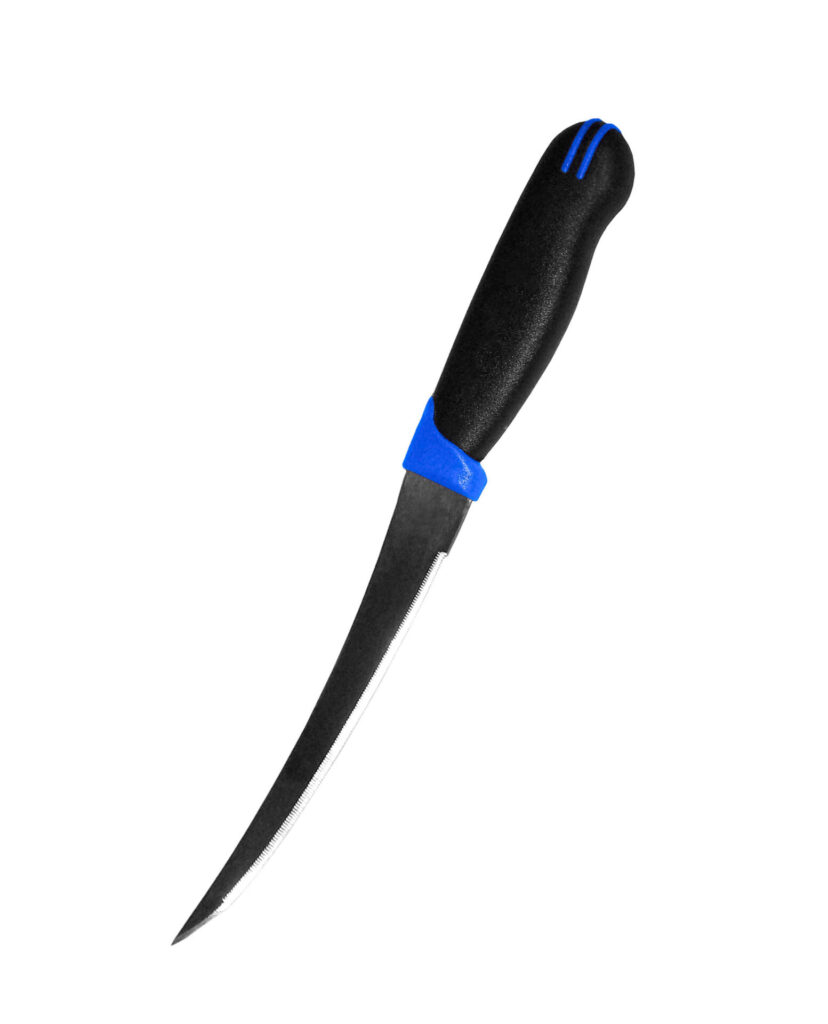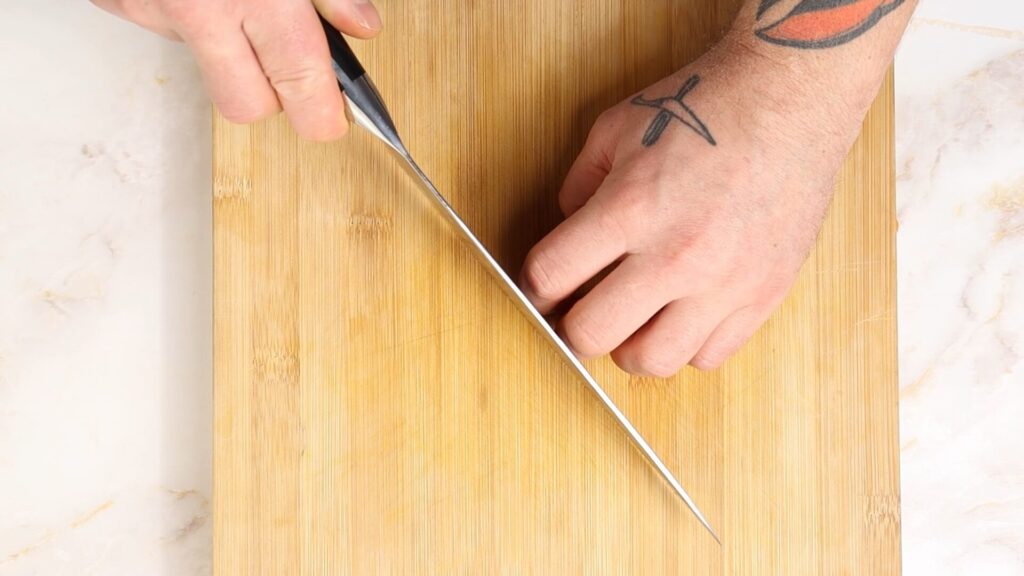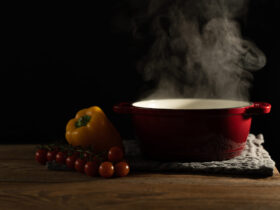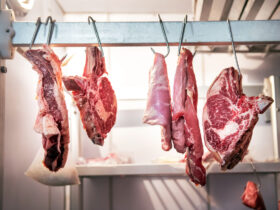One of the first steps to becoming a professional chef is to acquire the right equipment. Every profession has its basic tools to get started. As a chef, you need knives to perform your work quickly and safely.
With such a vast array of knife types, shapes, and brands available, it’s easy to feel overwhelmed when starting out. However, all you really need to begin in the kitchen is a small selection of knives.
Knives for starters
Chef's Knife
The most important and commonly used knife in the kitchen is undoubtedly the chef’s knife (also known as the French knife or chef knife). This type of knife is considered an all-purpose kitchen knife. It can be used for slicing vegetables and fruits, chopping herbs, or portioning fish and meat.
To start with, two knives are sufficient for beginning in the kitchen, and you don’t have to spend a lot of money on them. Also, when you’re starting your career, it’s not crucial to focus on a particular brand. It’s best to seek advice from a specialty store.
You can either opt for a chef’s knife with a classic French design or a Western-style Santoku.
A Western-style Santoku is a knife adapted for the rest of the world with a blade shape similar to a traditional Japanese knife. However, it’s not necessarily what you would consider a classic Japanese knife.


western Style Santoku
classic French Style Chef Knife
The right size for your first knife is up to you, as long as you stay within a range of 14-20cm blade length to start with. For learning cutting techniques and for easier handling, a smaller knife is advantageous. As you become more skilled and experienced, you can then opt for a larger knife.
Small all-purpose Knife
As a second knife to start with, you’ll need a small all-purpose knife, also called a paring knife. This is the smaller, lighter version of your chef’s knife, with a blade length of 8-14cm.

This knife is used for all tasks where the chef’s knife is simply too large. It’s perfect for cleaning and peeling vegetables and fruits, or for example, for peeling the skin off tomatoes. In any case, the paring knife or small all-purpose knife, along with your chef’s knife, will be your daily companions.
With these two knives, you actually have enough to start with, and even throughout your career as a chef, these two knives are among the most used in Western kitchens.
Breadknife
If you decide to expand your knife set afterward, we would definitely recommend getting a bread knife next. Most people are familiar with a bread knife, which shows how important it is. The serrated blade distinguishes the bread knife not only in shape but also in its area of use. Bread, crusts, and even delicate doughs are difficult to cut with a regular chef’s knife. There are basically two types of bread knives, with a pointed or a rounded end.

Anything you add after that is a bonus, but with these three knives, you can already handle all tasks and duties in a kitchen.
The most important types of Knives
Even though you only need 2 or even just one knife to start your career in the kitchen, we also want to discuss other important types of knives here, each with its own functions and advantages. In addition to the chef’s knife, the small all-purpose knife, and the bread knife, the following knives are also of great importance.
Filleting knife
The filleting knife is essentially like the chef’s knife but with a thinner and usually slightly longer blade. It’s perfect for cutting meat or filleting fish. The filleting knife is available with both a flexible and a rigid blade. However, opinions differ on which version might be more practical. Each version likely has its own advantages and disadvantages, and in the end, everyone must determine for themselves which knife they prefer to work with.

Boning knife
This knife is even thinner than the filleting knife and, as the name suggests, is primarily used for boning. This knife is a standard tool for butchers, but it is also commonly used in the kitchen. Thanks to its thin, sturdy blade, it’s perfect for separating meat from the bone, portioning meat, or removing tendons and silver skin.

Paring knife
The paring knife is a small knife like the paring knife, but its blade is curved, with the tip pointing downwards. This makes it perfect for trimming vegetables and working with round surfaces in general. Traditionally, the knife was used to create tourné cuts, which are small, barrel-shaped cuts on vegetables. However, these techniques are not as commonly used today. Nevertheless, the tourné knife remains a very practical and interesting knife to have in your collection.
Cleaver
For heavier tasks or chopping through bones or thick fish bones, the cleaver is advantageous. A cleaver has a short but wide and thick blade to perfectly handle this job. However, it’s completely sufficient to have just one cleaver per kitchen. It’s important to note that a cleaver should only be used on a chopping block or a thick board designated for this purpose, in order to avoid damaging regular cutting boards.
Proper knife handling
Knives should always be treated with a certain level of respect, both to protect yourself and to avoid damaging the knives. Even though good knives are designed to last a lifetime, they can still be damaged if mishandled.

One of the most important aspects of kitchen safety is handling knives correctly. When moving around the kitchen with a knife in hand, it’s essential to hold the knife properly. Hold the knife with the blade down by your side, with the sharp side of the blade facing backward.
When passing a knife to someone else, there are two options. The first option is to place the knife on a work surface, with the handle facing the person who will pick up the knife. The second option is to pass the knife directly to someone. In this case, grasp the knife by the dull side of the blade and pass it, handle facing away from you, to the other person.
When leaving your knife on a work surface or cutting board, never cover it with food or kitchen towels to avoid the risk of someone accidentally injuring themselves.
To maintain your knives, they must always be kept clean. After using a knife, rinse it with some dish soap under warm water, if you have time. This is especially important if you have been cutting meat or fish to avoid cross-contamination. Most importantly, never wash your knives in the dishwasher, as this will dull the blade. However, you can safely wash your knife in hot water; the steel of your knife will not be damaged. The temperatures required to damage the steel are ones your hands couldn’t tolerate anyway.
To work efficiently and safely, always keep your knives sharp. Dull knives increase the risk of injury because the blade can slip instead of cutting.
The use of a honing steel
Erstens sollten wir uns mit dem Thema Wetzstahl beschäftigen. Genauer gesagt handelt es sich dabei eigentlich nicht um Schärfen, da du nur minimal Material abträgst. Mit einem Wetzstahl richtest du eigentlich nur die Klinge wieder gerade. Wenn du ein Messer häufig benutzt, entsteht an der Klinge ein kleiner Grat mit einer leichten Krümmung. Das ist mit bloßem Auge nicht sichtbar. Ein Wetzstahl richtet diese mikroskopisch kleinen Grate wieder aus und begradigt so die Klinge. Dadurch fühlt sich die Klinge automatisch wieder schärfer an und du kannst gut damit arbeiten. Das Abziehen mit dem Wetzstahl ersetzt jedoch nicht das Schärfen.

Wetzstähle gibt es in verschiedenen Längen, Formen und Materialien. Metallwetzstähle sind am weitesten verbreitet, aber es gibt auch Wetzstähle mit Glas-, Keramik- oder Diamantbeschichtung.
Beim Verwenden eines Wetzstahls halte das Messer fast vertikal mit der Klinge in einem 20°-Winkel. Ziehe nun das Messer vom hinteren Ende über die gesamte Länge des Wetzstahls. Wechsle dabei nach jedem Zug die Seite der Klinge.













Leave a Reply
View Comments